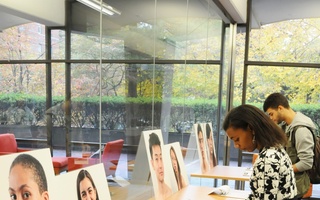When I walked into the Carpenter Center on April 5, I was greeted by a horde of bespeckled sophisticates, a handful of retro twenty-somethings, and a lascivious old French man who gave me two martinis. I felt as though I had been transported into another era.
In fact, I was simply attending the opening of “When We Liked Ike: Looking for Postwar America,” a photography exhibit running through April 29 at the Carpenter Center. The exhibit uses household objects, quotations and photography to give insight into the 1950s, a period that conjures up an ambivalent mixture of nostalgia, disgust and curiosity in the modern viewer. The photographs, which are organized by theme, address topics such as childhood, the teenage years, marriage, suburbia, economic expansion, racist stereotyping and politics.
With its reliance on household objects such as clocks, shot glasses, ashtrays and lamps, “When We Liked Ike” is not a traditional exhibit of high art. Instead, the exhibit provides a light, amusing and thought-provoking documentation of a period of American history.
Entering the exhibit, the viewer is immediately confronted by a row of beaming all American girls taking part in a swimsuit competition and a photograph of shining, brand-new-car emblems of suburban bliss. The next series of images are photographs of gray-faced politicians, young children who are being indoctrinated by them, diners, an automobile factory and an actual television. The accompanying quote, “There is an abundance of evidence to sustain the conclusion that the indulgence in acts of sexual perversion weakens the moral fiber to a degree that he is not suitable for a position of responsibility,” accompanies these sterile images and reveals the underlying tensions that hide behind the false front of serenity in the photographs.
This kind of juxtaposition of quotations and images continues throughout the rest of the exhibit. Next to pictures of rows of docile school children with crossed hands and obedient expressions, and happy children engaging in healthy, innocent activities is the quotation, “A great many school children have been damaged by the spinster teacher, who cannot be an adequate model of a complete woman.” The quotation is used in direct opposition to the serenity of the children, and causes the viewer to reexamine the series of images presented.
The next series demonstrates marital and domestic bliss through photographs of perfectly manicured lawns, gleaming kitchen appliances, content housewives and masculine husbands. Just when the viewer is about to look back on those good old days with fondness, he is jilted out of his daydream after reading a remark about why a husband loved his wife: “She was submissive and she worshiped him, and it was for those reasons that he had loved her.”
Although the subjects of the photographs are predominantly white, this cultural monochrome is punctuated by photographs of a black boy shining a white man’s shoes, images of an African American wedding, white men in blackface, white girls dressed up as Native Americans. Although the photographers’ aims were not to capture images of racism, a quotation by James Baldwin reveals the racism that was deeply ingrained in American society. Photographs of poverty, slums, traffic and over-crowding reveal the negative effects of economic expansion.
Barbara Norwood, the curator of the exhibit, says, “These candids taken by photographers are social documents of the best kind. The goal of such photographs was to take photographs that would please. If the photographs were to be successful, they had to respond to the attitudes prejudices, and values of their clients.” By doing this, the photographers also inadvertently demonstrate the narrow mindedness of hypocrisy of an era that was going to be transformed by the 60s.
Read more in Arts
Something Borrowed: Sir Thomas More, the Musical!Recommended Articles
-
Sight-Seeing or Seeing Sights?"Seeing is believing" is a common mantra in Western culture, and in the artistic world, photography is, for many, the
-
Capturing a City’s Character and LifeCities can have lives of their own—and New York City is no doubt a living entity, as a current exhibition
-
A Tragic ExhibitWASHINGTON—In a city that prides itself on its stunning monuments to soldiers and presidents who lived and died for this
-
Wenders Exhibits PhotosTo fans of cinema, Wim Wenders is best known as the director of Wings of Desire, which garnered several prestigious
-
 Photo Gallery Highlights Multiracial Student Experiences
Photo Gallery Highlights Multiracial Student Experiences













